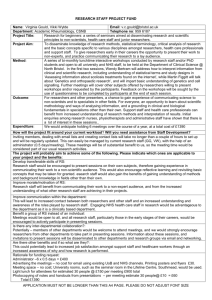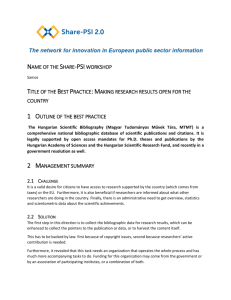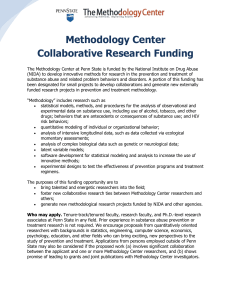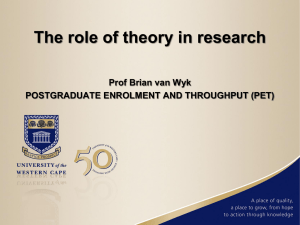3. Pure cultivation
advertisement
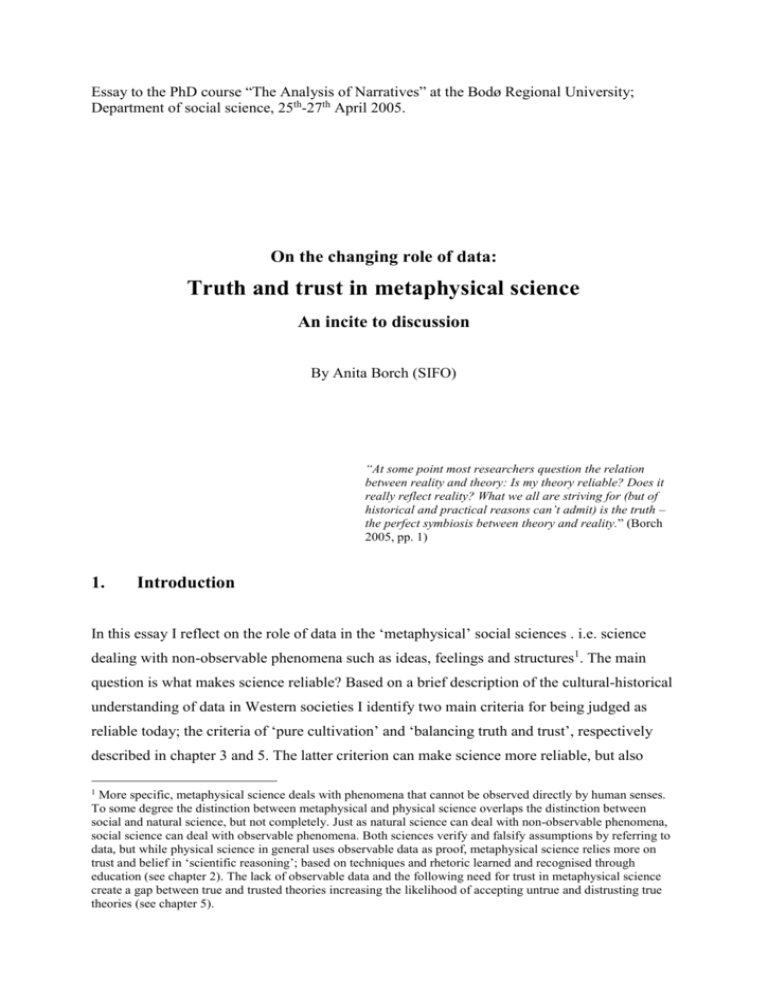
Essay to the PhD course “The Analysis of Narratives” at the Bodø Regional University; Department of social science, 25th-27th April 2005. On the changing role of data: Truth and trust in metaphysical science An incite to discussion By Anita Borch (SIFO) “At some point most researchers question the relation between reality and theory: Is my theory reliable? Does it really reflect reality? What we all are striving for (but of historical and practical reasons can’t admit) is the truth – the perfect symbiosis between theory and reality.” (Borch 2005, pp. 1) 1. Introduction In this essay I reflect on the role of data in the ‘metaphysical’ social sciences . i.e. science dealing with non-observable phenomena such as ideas, feelings and structures1. The main question is what makes science reliable? Based on a brief description of the cultural-historical understanding of data in Western societies I identify two main criteria for being judged as reliable today; the criteria of ‘pure cultivation’ and ‘balancing truth and trust’, respectively described in chapter 3 and 5. The latter criterion can make science more reliable, but also 1 More specific, metaphysical science deals with phenomena that cannot be observed directly by human senses. To some degree the distinction between metaphysical and physical science overlaps the distinction between social and natural science, but not completely. Just as natural science can deal with non-observable phenomena, social science can deal with observable phenomena. Both sciences verify and falsify assumptions by referring to data, but while physical science in general uses observable data as proof, metaphysical science relies more on trust and belief in ‘scientific reasoning’; based on techniques and rhetoric learned and recognised through education (see chapter 2). The lack of observable data and the following need for trust in metaphysical science create a gap between true and trusted theories increasing the likelihood of accepting untrue and distrusting true theories (see chapter 5). reduce the ability of science to realise its raison d'être; the ontological obligation of bringing the world (of knowledge) closer to the truth2. A cultural-historical description of the role of empirical data in science involves, of course, a myriad of temporally and spatially based understandings far to complex to be told within the limit of an essay. The story has therefore been strongly simplified; cut down to the bone and presented as if dealing with a linear course of events rather than interwoven processes running side-by-side with varying degrees of intensity. I have done this “harassment” without too many scruples, reminding myself of the fact that the aim of this essay never has been to document the complexity of these understandings, but to draw some general lines that can make a starting point for further discussion about how we reflect on these issues today. 2. Data as facts – a culture-historical framework Before the scientific revolution of the 16th and 17th centuries there was a general understanding in Western societies that the truth was given by God and written in the Bible and in nature, God’s Creation. However, as modern civilisation grew and social mobility increased, people could see with their own eyes that others – neighbours, family and friends – where able to change their lives, for instance by investments in the market. Slowly the dominant ontology and epistemology changed3. The truth was not necessarily written in the Bible, but something that had to be experienced through human senses; something that couldn’t be claimed, but had to be discussed and preferably proven. The general rules were: No observable data, no truth; the more observable, the truer. The early modern understanding reached its most extreme in the 1920s when the logical positivist refused to accept any metaphysics as true. Only sense data deduced from ‘The truth’ refers in this respect to an external reality independent of human senses. During the last decades this traditional ontological understanding of reality has been challenged by alternative notions seeing reality as subjective ‘inner realities’ or textual realities ‘as such’ with no obvious link to the truth (see also chapter 4 and 5). However, since most of these researchers nevertheless research external phenomena, i.e. realities ‘outside’ themselves, it might be questioned whether these new ways of thinking actually represent alternative ontologies or just nuances of the traditional. 3 There has to be mentioned that scientists kept God as an indisputable part of science for about four hundred years, typically regarding him as the big organiser of science and nature. In the early 20th century, however, the secularisation process had sufficiently undermined religious worldviews among scientists. A professional philosophy of natural science had been developed, via Comte, Mill, the late 19 th century materialism and the logical positivism (Mjøset 2005). 2 2 controlled experiments should be regarded as true – under the precondition that they were carefully registered, sentence-by-sentence, so that followers could be able to control the results. The idea of ‘protocol sentences’ met, however, resistance, particularly among social scientist arguing that most phenomena cannot be observed. In fact, if scientists really took the bull by the horn and excluded all metaphysics from their work, there would be very few phenomena left to research (Hackings 1983; Mjøset 2005). Hence, in order to save science most scientists modified their ideal of an observable truth. The truth was not necessarily something that could be observed, but something that could be represented and understood by means of theories verified or falsified, induced or deduced, from thought experiments and empirical data. Like in the pre-modern period, the truth was no longer something that had to be proven by human senses, but a question of belief – a belief that could not be claimed, but had to be earned, trusted and won, not based on piety, but on a specialised way of reasoning; scientific rhetoric and techniques, learned and recognised through education. The aim was no longer to copy reality, but to provide solid and vital theories of reality able to defy the ages. The term truth became totally out of fashion and almost vanished from science. Rather than talking about truth, scientists discussed whether theories could be regarded as “reliable”; sufficiently and scientifically grounded4. One point was the representativeness of the data – to what degree the findings could be generalised to other, preferably greater, realities. The new rules were more humble: the better data, the more reliable. The data represented, in other words, a key to trustworthiness; in many ways replacing human senses; procuring the observable proofs needed for science to be trusted. Not to question the source of trust, researchers took the role of distant observers. Data were presented as facts (Latour 1979). Strengths were highlighted, weaknesses covered up, or at the best accounted for in chapters particularly dealing with methodology (de Lane 2000; Plummer 2001). 4 Even though most scientists refused the idea of a scientific truth, they kept the belief in an external (true) reality independent of human thought that could be analysed and understood, good or bad. The change seemed, in other words, more epistemological than ontological. 3 3. Pure cultivation Modified and reduced from a science of ‘true’ descriptions into a science based on trustworthy and ideally robust theories social science entered its Golden Age in the 1950s. The World War 2 had ended and great social engineering projects aiming to rebuild the society started. More scientists were needed and the education system was democratised. Since then old and new ways of reasoning have been developed and categorised as “functionalism”, “structuralism”, “rational choice”, “behaviourism”, “phenomenology”, “post-structuralism” etc. (Ritzer 1983). Today’s understanding of data seems to be in a time of upheaval. On one level the modern rules stand firm; the better data, the more reliable5. On another level, however, the understanding seems to differ, among others between “research attitudes”, as they have been described by Mjøset’s (2005) in his recent work, “Six notions of theory in social science” 6. Inspired by this work it might be suggested that present researchers tend to use and trust different types of data. In short, researchers inspired by natural science tend to trust statistical data based on many “observations”, researchers influenced by social science tend to trust data based on case studies emphasising the meaning of contexts, and researchers more open to humanistic science tend to trust systematic interpretation of texts, such as work of religion, art, philosophy, popular entertainment, trajectories of concepts/ideas etc. Moreover, researchers tending to use one kind of data tend to distrust other. Indeed, it might be argued that different kinds of data represent important pieces in the big puzzle of reality. Considered, however, that adherents of each attitude tend to legitimise their own data by questioning and criticise others, it can be suggested that methods are used as weapons in a battlefield where adherents of different attitudes are fighting for power; financial support and social respect. Hence, due to these seemingly Bourdieuan integrating and distinguishing processes (Bourdieu 1992) in the present field of social science, it might be argued that an important criteria for being judged as reliable is not (only) valid data as such, but (also) a pure cultivation of trusted data identified and recognised as distinct from ‘others’. 5 Thus, it might be suggested that the claim for observable data has weakened. In fact, some significant scientists particularly dealing with the relation between theory and reality have assumed that metaphysics can be regarded as truer than physics. Ian Hacking, for instance, claimed in the 80-ties that “average a priory fantasy about human” might be truer than “disinterested observation and mathematical model-building of cognitive science” (Hackings 1983:131). About ten years later Richard Sennett, suggested that in post-modern societies “superrealities” (expressed through media) is generally understood as more real than (self-experienced) “realities” (Sennett 1993). 6 Inspired by Mjøset (2005) today’s social science might be seen as a slow moving field consisting of a myriad of ideas regarding adequate research purpose, level of analysis, terminology, method etc. tending to constitute three identifiable and assumingly internal logical “research attitudes” corresponding to the main disciplines of science; natural, social and humanistic science. 4 4. Reflexivity Of course, adherents of the same research attitude do not always agree. In fact, like in most Bourdeuan fields most discussions do not take place across, but within each attitude7. As the internal discussions continue and specialisation increases, science seems to become more nuanced and reflexive, for example when it comes to the limitations of data. The exposure of reflexivity is not unambiguous, but tends to differ. For instance, researchers inspired by natural science tend to focus on the representativeness of data, researchers influenced by social science tend to focus on the influence of the researchers during fieldwork, and researchers more open for humanistic science tend to focus on the limitation of seeing – or, more specific; not seeing – data as text. In the next chapters I explore the latter kinds of reflexivity; reflexivity related to fieldwork and text analysis. Fieldwork Truly inspired by the constructivist and phenomenological ideas of Husserl, Schutz, Berger and Luckmann some fieldworkers tend to assume that the reality gets its meaning as it is processed by human beings and in that respect exists as much ‘inside human beings’ as ‘out there’. Thus, rather than seeing themselves as distant observers, these researchers tend to see themselves as participating co-producers of realities. Their reflexivity does not only deal with the power of the researchers, but also with ethical dilemmas related to the many experiences and choices made during fieldwork, i.e. connected to their many and sometimes contradicting roles, for example of being both (distant) ‘scientist’ and (intimate) ‘fellow men’. Contrary to the modern notion of science, the emotional and ethical work is not hidden, but clearly exposed, not necessarily in chapters dealing with methodology, but discussed and interwoven in the remaining text where they seem relevant (de Lane 2000; Plummer 2001). Research is, in other words, exposed as the reflexive process it truly is; less as facts and more like qualified entrances for discussions. Even though this change of practise represents a more realistic notion of metaphysical data, these researchers can be accused of being too selfIt might be suggested that Mjøset’s three attitudes consist of more specialised approaches, for instance that the attitude inspired by social science consist of smaller approaches to some degree corresponding to the different disciplines within this field; economy, psychology, sociology, anthropology etc. However, the point here is not to emphasise the manifold of approaches, rather to underline the fact that the attitude towards data and methodology are present in all of the disciplines, although in varying degree. 7 5 oriented and too emotionally bound to the informants. Hence, in order not to harm the source of trust, most researchers today seem to expose their reflexivity in manners that do not question their objectivity. Rather than seeing themselves as co-producers, they keep the role as distant observers, at the most arguing that they are changing between intimate and distant positions. The many experiences and choices made during fieldwork are generally discussed as something that increases the trustworthiness of data, not decreasing it. In fact, reflexivity leading to the conclusion that data cannot be trusted is conspicuously rare, almost nonexisting. In this respect it might be argued that the exposed reflexivity of today does not (only) aim to evaluate data in order to bring the research closer to reality, but (also) to make data seem more reliable than they are and hence fulfil the expected validity criteria of modern times. Data as text Influenced by the linguist structuralism of Saussaure some researchers tend to understand the world as a system of signs. Since a sign has no meaning as such, but gets meaning in connection with others signs, reality can be understood through systematic analyses of the relation between signs (Dalseth 1969; Korsenes et al 1997). Data are not seen as representing an ‘inner’ or ‘outer’ reality, but rather a reality ‘as such’; a reality with no obvious link to the truth; and hence has to be understood as ‘any other texts’, religious and (other) metaphysical texts included. While some researchers do not relate the textual data to a reality ‘out there’, but deepen into the text, others emphasise the gap between them, at the most extreme suggesting that scientific texts constitute some of the many reproductive, structural discourses of power repressing marginalised groups of society (i.e. Foucault 1988; 1990). While the modern notion of data are being criticised for being too naïve or ambiguous, the present notions can be accused of being respectively too introvert or “paranoid” to be taken seriously in the modern engineering project of science. 5. Balancing truth and trust Hence, during the last decades the dominant notion of modern science has been challenged by late/postmodern approaches highlighting the limitations of data. Some have deconstructed dominant texts, suggesting that there is no obvious link between theories and a reality ‘out 6 there’. Others have tried to reduce the gap, suggesting that science must become more reflexive, especially when it comes to the influence of the many emotional and ethical decisions made during the research process. The attempts at alternative thinking have met resistance, partly because they threaten the trustworthiness of science. The new approaches might be more realistic than the dominant. At stake, however, is the power of science. It seems, in other words, to be a gap between two fundamental and seemingly contradicting aims of metaphysical science today: the ontological obligation of bringing the world closer to the truth on one side, and the existential need of being trusted on the other. While the former argues for a more realistic notion of data; data as qualified entrances for discussion, the latter speaks for stability; of seeing data as facts. Hence, finding an acceptable point of balance between the early modern and late/postmodern understanding of data appears to be a significant criterion for being judged as reliable today. An interesting question is if, and in that case how, the point of balance will change in the future. Will the gap decrease if researchers agree that there in fact is no necessary contradiction between the two aims of metaphysical science; that a more realistic notion of data rather strengthens than weakens the trustworthiness of science? Or will it rather decrease if researchers start/continue romanticise “the good old days” when science gave clear answers, the world made sense and the economic and social life was in progress? For all we know the balancing of modern and late/postmodern notion of data is not (only) about trustworthiness and power, but (also) based on a human need for ‘ontological security’ (Giddens 1984) – a feeling of confidence and trust in the world as it appears to be, truth or not. 6. Closing remark While most narratives dealing with the role of data has highlighted the difference between natural and social science8, macro and micro perspectives, qualitative and quantitative methods etc., this story has been dramatised around one particular dichotomy; the contrast between the observable and not observable; between “believers” and “not believers” in metaphysical science. My choice of focus is, of course, not accidental, but is rooted in the 8 Even though the essay deals more with social than natural science, I have chosen not to stress this division, mainly because some of the described problematic aspects and validity criteria related to metaphysical science seem present in natural science as well, although in varying degree (i.e. Latour 1986; Hackings 1983). 7 modern concern that the striving for observable proves is basically where science distinguishes from religion and (other) mythical worldviews. The more we move from this ideal, the more legitimising problems we get. At the same time it would be rather ridiculous – even self-destructive – to take the logical positivist stand arguing that all metaphysics should be excluded from science. Many researchers dealing with metaphysics today seem to suggest that they can “prove” reality by referring to their data material. It might be that the data material represents a step closer to the truth. But not from necessity. This essay has identified two criteria for being judge as reliable today, the criteria of ‘pure cultivation’ and ‘balancing truth and trust’. Other important criteria could have been highlighted, such as the seemingly unimportant symbolic value of the reference list, publication list, university, advisers, colleagues etc. That is, however, another story… Literature Borch, Anita (2005): What makes science reliable? A culture-historical incite to discussion. Essay to the course in social science theory at the University of Oslo, spring 2005. Bourdieu, Pierre (1992): Distinction. A Social Critique of the Judgement of Taste. London: Routledge. Berger, Peter L. and Thomas Luckmann (1966): The Social Construction of Reality: A Treatise its the Sociology of Knowledge. New York: Anchor Books. Dalseth, Eyvind (1969): Filosofisk leksikon. Oslo: Fabritius Ordbøker. De Lane, Marlene (2000): Fieldwork, Participation and Practice. Ethics and Dilemmas in Qualitative Research. London: Sage Publicatos Ltd. Foucault, Michel (1988): Madness and Civilization: A History of Insanity in the Age of Reason. New York: Vintage. Foucault, Michel (1990): The History of Sexuality. Volum 1: An Introduction. New York: Vintage Books. Giddens, Anthony (1984): The Constitution of Society. Cambridge: Polity Press. Hacking, Ian (1983): Representing and intervening. Introductory topics in the philosophy of natural science. Cambridge University Press 1983. Hacking, Ian (1999): Social Construction of what? London: Harvard University Press. 8 Korsnes, Olav, Heine Andersen og Thomas Brante (1997): Sosiologisk leksikon. Oslo: Universitetsforlaget.Mjøset, Lars (2005): Six notions of theory in the social science. Work in progress. Latour, Bruno (1993): We have never been modern. New York: Harvester Wheatsheaf. Latour, Bruno (1979): Laboratory Life: The Social Construction of Scientific Facts. Beverly Hills: Sage Publication. Plummer, Ken (2001): Documents of life 2. An Invitation to a Critical Humanism. London: Sage Publications. Ritzer, George (1983): Contemporary sociological theory. New York: Knopf. Sennet, Richard (1993): The Fall of Public Man. London: Faber and Faber. 9



